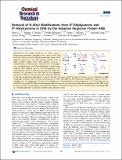Removal of N-Alkyl Modifications from N[superscript 2]-Alkylguanine and N[superscript 4]-Alkylcytosine in DNA by the Adaptive Response Protein AlkB
Author(s)
Li, Deyu; Fedeles, Bogdan I.; Shrivastav, Nidhi; Delaney, James C.; Yang, Xuedong; Wong, Cintyu; Drennan, Catherine L.; Essigmann, John M.; ... Show more Show less
DownloadDrennan_Removal of N.pdf (638.2Kb)
PUBLISHER_POLICY
Publisher Policy
Article is made available in accordance with the publisher's policy and may be subject to US copyright law. Please refer to the publisher's site for terms of use.
Alternative title
Removal of N-Alkyl Modifications from N2-Alkylguanine and N4-Alkylcytosine in DNA by the Adaptive Response Protein AlkB
Terms of use
Metadata
Show full item recordAbstract
The AlkB enzyme is an Fe(II)- and α-ketoglutarate-dependent dioxygenase that repairs DNA alkyl lesions by a direct reversal of damage mechanism as part of the adaptive response in E. coli. The reported substrate scope of AlkB includes simple DNA alkyl adducts, such as 1-methyladenine, 3-methylcytosine, 3-ethylcytosine, 1-methylguanine, 3-methylthymine, and N6-methyladenine, as well as more complex DNA adducts, such as 1,N6-ethenoadenine, 3,N4-ethenocytosine, and 1,N6-ethanoadenine. Previous studies have revealed, in a piecemeal way, that AlkB has an impressive repertoire of substrates. The present study makes two additions to this list, showing that alkyl adducts on the N2 position of guanine and N4 position of cytosine are also substrates for AlkB. Using high resolution ESI-TOF mass spectrometry, we show that AlkB has the biochemical capability to repair in vitro N2-methylguanine, N2-ethylguanine, N2-furan-2-yl-methylguanine, N2-tetrahydrofuran-2-yl-methylguanine, and N4-methylcytosine in ssDNA but not in dsDNA. When viewed together with previous work, the experimental data herein demonstrate that AlkB is able to repair all simple N-alkyl adducts occurring at the Watson–Crick base pairing interface of the four DNA bases, confirming AlkB as a versatile gatekeeper of genomic integrity under alkylation stress.
Date issued
2013-08Department
Massachusetts Institute of Technology. Center for Environmental Health Sciences; Massachusetts Institute of Technology. Department of Biological Engineering; Massachusetts Institute of Technology. Department of ChemistryJournal
Chemical Research in Toxicology
Publisher
American Chemical Society
Citation
Li, Deyu, Bogdan I. Fedeles, Nidhi Shrivastav, James C. Delaney, Xuedong Yang, Cintyu Wong, Catherine L. Drennan, and John M. Essigmann. “Removal of N-Alkyl Modifications from N2-Alkylguanine and N4-Alkylcytosine in DNA by the Adaptive Response Protein AlkB.” Chemical Research in Toxicology 26, no. 8 (August 19, 2013): 1182-1187.
Version: Final published version
ISSN
0893-228X
1520-5010